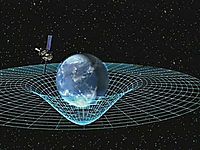
Photo from wikipedia
We investigated the efficacy of graph-theoretic metrics of task-related functional brain connectivity in predicting reading difficulty and explored the hypothesis that task conditions emphasizing audiovisual integration would be especially diagnostic… Click to show full abstract
We investigated the efficacy of graph-theoretic metrics of task-related functional brain connectivity in predicting reading difficulty and explored the hypothesis that task conditions emphasizing audiovisual integration would be especially diagnostic of reading difficulty. An fMRI study was conducted in which 24 children (8 to 14 years old) who were previously diagnosed with dyslexia completed a rhyming judgment task under three presentation modality conditions. Regression analyses found that characteristic connectivity metrics of the reading network showed a presentation modality dependent relationship with reading difficulty: Children with more segregated reading networks and those that used fewer of the available connections were those with the least severe reading difficulty. These results are consistent with the hypothesis that a lack of coordinated processing between the neural regions involved in phonological and orthographic processing contributes towards reading difficulty.
Journal Title: PLoS ONE
Year Published: 2018
Link to full text (if available)
Share on Social Media: Sign Up to like & get
recommendations!